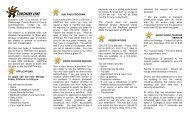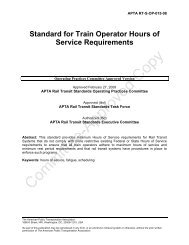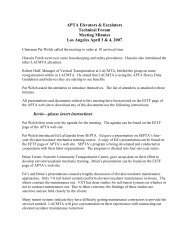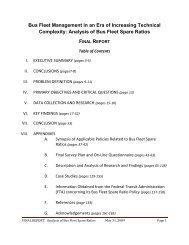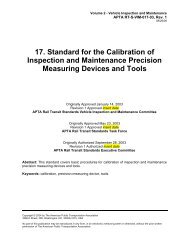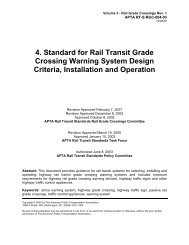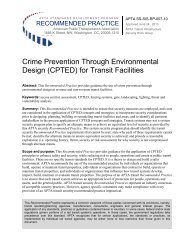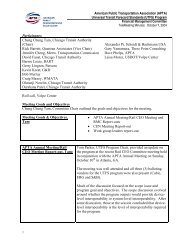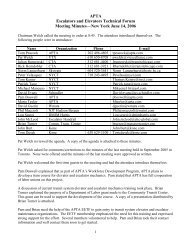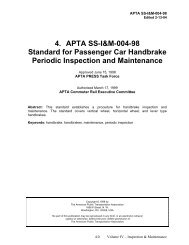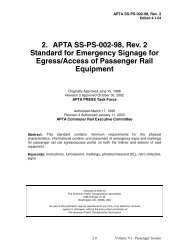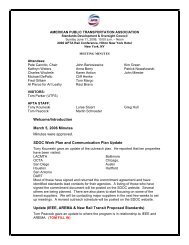Standard Bus Procurement Guidelines - APTAStandards.com
Standard Bus Procurement Guidelines - APTAStandards.com
Standard Bus Procurement Guidelines - APTAStandards.com
You also want an ePaper? Increase the reach of your titles
YUMPU automatically turns print PDFs into web optimized ePapers that Google loves.
<strong>Standard</strong> <strong>Bus</strong> <strong>Procurement</strong> <strong>Guidelines</strong><br />
5.4.7.4.2 Materials<br />
Baseline: Use for safety glass<br />
glazing panels.<br />
Side windows glazing<br />
material shall have a 1/4-inch<br />
nominal thickness tempered<br />
safety glass. The material<br />
shall conform to the<br />
requirements of ANSI Z26.1<br />
Test Grouping 2 and the<br />
Re<strong>com</strong>mended Practices<br />
defined in SAE J673.<br />
Alternative: Use for<br />
polycarbonate glazing panels.<br />
Also see Section 5.1.5.2.<br />
Side window glazing material<br />
shall have a 1/4-inch nominal<br />
thickness. The material shall<br />
conform with the<br />
requirements of<br />
ANSI Z26.1-1977 <strong>Standard</strong><br />
for Type AS-5 Safety Glazing<br />
Materials except for Test<br />
Number 17 which shall<br />
subject the specimens to 1000<br />
cycles and the arithmetic<br />
mean of the percentages of<br />
light scattered shall not<br />
exceed 5 per cent. Windows<br />
shall be polycarbonate sheet<br />
with an abrasion resistant<br />
coating on both sides of the<br />
window.<br />
Alternative: Use for acrylic<br />
glazing panels. Also see<br />
Section 5.1.5.2.<br />
Side window glazing material<br />
shall have a 1/2-inch nominal<br />
thickness. The material shall<br />
conform with the<br />
requirements of<br />
ANSI Z26.1-1977 <strong>Standard</strong><br />
for Type AS-5 Safety Glazing<br />
Materials except for Test<br />
Number 17 which shall<br />
subject the specimens to 1000<br />
cycles and the arithmetic<br />
mean of the percentages of<br />
light scattered shall not<br />
exceed 5 per cent. Windows<br />
shall be cell cast acrylic sheet<br />
with an abrasion resistant<br />
coating on both sides of the<br />
window.<br />
Windows on the bus sides and in the rear door shall be tinted a neutral color, <strong>com</strong>plementary to the<br />
bus exterior. The maximum solar energy transmittance shall not exceed 37 percent, as measured by<br />
ASTM E-424, and the luminous transmittance shall be no less than 16 percent as measured by ASTM<br />
D-1003. Windows over the destination signs shall not be tinted.<br />
5.4.8 HEATING VENTILATING AND AIR CONDITIONING<br />
5.4.8.1 CAPACITY AND PERFORMANCE<br />
The Heating, Ventilation and Air Conditioning (HVAC) climate control system shall be capable of<br />
maintaining the interior of the bus at the temperature and humidity levels defined in the following<br />
paragraphs.<br />
With the bus running at the design operating profile and carrying a number of passengers equal to<br />
150 percent of the seated load, the HVAC system shall maintain a passenger <strong>com</strong>partment<br />
temperature within a range between 65Ε and 80Ε F, while controlling the relative humidity to a value<br />
of 50 percent or less. The cooling requirements shall be based on each passenger generating 270 Btu<br />
per hour of sensible heat and 270 Btu per hour of latent heat. The system shall maintain these<br />
conditions while subjected to any outside ambient temperatures within a range of 10Ε to 95Ε F and at<br />
any ambient relative humidity levels between 5 and 50 percent. When the bus is operated in outside<br />
ambient temperatures of 95Ε to 115Ε F, the interior temperature of the bus shall be permitted to rise<br />
one degree for each degree of exterior temperature in excess of 95Ε.<br />
Technical Specifications 182 10/18/07



